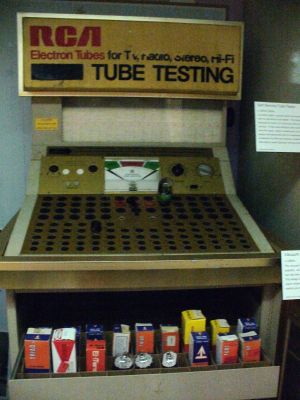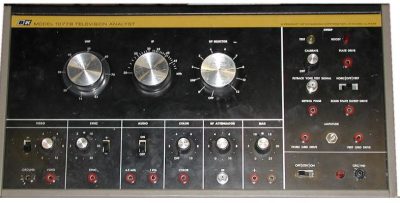As technology advances, finding the culprit in a malfunctioning device has become somewhat more difficult. As an example, troubleshooting an AM radio is pretty straightforward. There are two basic strategies. First, you can inject a signal in until you can hear it. Then you work backwards to find the stage that is bad. The other way is to trace a signal using a signal tracer or an oscilloscope. When the signal is gone, you’ve found the bad stage. Of course, you still need to figure out what’s wrong with the stage, but that’s usually one or two transistors (or tubes) and a handful of components.
A common signal injector was often a square wave generator that would generate audio frequencies and radio frequency harmonics. It was common to inject at the volume control (easy to find) to determine if the problem was in the RF or audio sections first. If you heard a buzz, you worked backwards into the RF stages. No buzz indicated an audio section problem.
A signal tracer was nothing more than an audio amplifier with a diode demodulator. Starting at the volume control was still a good idea. If you heard radio stations through the signal tracer, the RF section was fine. Television knocked radio off of its pedestal as the primary form of information and entertainment in most households, and thus the TV repair industry was created.
The Columbus Method
 Old analog TVs, however, are a little more complicated. You can’t easily trace all the signals in a TV. When TVs used tubes, it was a good bet that one of the tubes gone bad. A dark tube was always a bad sign. Drugstores and other retail shops had tube testers (see right) and actually sold replacement tubes. You could take the back off your TV, test your tubes, buy replacements for any bad tubes, and (probably) fix your TV set.
Old analog TVs, however, are a little more complicated. You can’t easily trace all the signals in a TV. When TVs used tubes, it was a good bet that one of the tubes gone bad. A dark tube was always a bad sign. Drugstores and other retail shops had tube testers (see right) and actually sold replacement tubes. You could take the back off your TV, test your tubes, buy replacements for any bad tubes, and (probably) fix your TV set.
This style of troubleshooting is often known as “Easter egging” or “the Columbus method” or, simply, “hunt until you find it.” The reason it worked is that tubes were the most likely failure.
TV Station in a Box
Of course, that didn’t always work. With solid state TVs, you probably couldn’t use that option, anyway. Pro repairmen had a lot of tricks. An oscilloscope is great if you know what the signals should look like. You could also get small boxes that created a few test patterns. However, the gold standard for TV repair was the TV Analyst made by B&K (see below).
It might not look like much, but this unassuming box was a little TV station that fit on your bench. Every signal comes out to the front panel so you can inject it. The source of the signal was a CRT and a photo tube. The CRT scanned a transparency of a test image and the photo tube generated the signal. The CRT was actually a special type that emitted UV light that works well with the photo tube and had a short persistence.
Naturally, this was a black and white affair, however, the Analyst also had a color bar generator for working on color sets. These were not cheap, but if you had a lot of TVs you worked on, you could earn the cost back pretty quickly.
Using the analyst was easy. You fed the output to the TV’s input. Presumably, since the TV needed fixing, something would be wrong. The screen might be black or rolling or maybe there was no audio. You’d locate a suspect stage (the audio, or the vertical sync, for example) and use the corresponding output from the analyst to inject the signal into the set. If things started working, you’ve found the problem area. In some cases, you’d move backwards through the circuit until things quit working again to figure out the problem.
Just like radio repair, you still had to figure out what is wrong with the circuit. But narrowing it down to one area was a big help.
How the Other Half Lived
Of course, not everyone had a device like this. In fact, most people who fixed TVs didn’t have one. Realistically, if you were smart enough, you didn’t need anything more than an oscilloscope. You could often get by with even less. Even though the Columbus method wasn’t very helpful for early solid state sets, many later model TVs went modular, so you could Easter egg modules instead of tubes until the TV started working again. If you had enough spare boards, you could just try replacing modules and maybe get lucky.
Of course, analog sets are old tech today. Today’s TVs don’t have tubes, and good luck troubleshooting the circuit boards inside. It is still possible to repair them, of course, but that procedure certainly won’t require a trip to the local drug store.

















You could take an old tv set, the picture tube didn’t have to be perfect, and bring the signals out to use as a piece of test equipment. I cant remember what they sad about AC/DC sets. But you’d get all the needed signals that way. I think this was described in a hobby electronic magazine soon after I started reading tem, because it was later that I saw tge same thing done with an AM radio.
Michael
I remember using coax to jumper the tuner output from a Zenith color tube TV to the IF input of a Philco solid state TV and visa-versa to do this. I told me that the the Philco had a good tuner and a bad IF module. I replaced the IF board and it worked for many years after.
ah what a rip! no videos
most retrotechtaculars are videos
I used to repair TVs for fun. (well, there was no profit in it after the 80s). My favourites were the Philips chassis which found their way into a myriad of different manufacturers sets. I particularly liked playing with convergence, using a cross-hatch generator and multiple patterns. Most dead TVs were down to the line output stage catching fire, or just exploding taking the line output transformer with it. Occasionally there was a tripler failure, which caused some hair-raising techniques of shorting out the HT on the tube to ground so you could safely swap them. If it got more subtle than that, it was often a component that didn’t like the heat, so it was judicious use of a freezer spray and a hot air gun to find the region of interest, and then the offending component usually would be found.
I still use the hot and cold method today – I have a Sony home cinema amp in the office/lab/workshop whose HDMI board refused to come out of mute – I found some cold joints on the HDMI board with a heat gun. Open amp, connect speakers, power on, tune a radio station in and wave hot air gun around until suddenly it wakes up.
I work at a TV station, and have had my share of “Outer Limits Syndrome” (eg: “We control the Horizontal and the Vertical.” The best tester for those repairs is the trusty ESR meter. There is nothing worse than a cap failing (even if there is no bubbled top…which is the usual visual cue of a bad set. The best tools for CRT’s today are a volt meter, ESR meter, O-scope and…if you can find one to stop “CRT Blooming”…a Sencore CRT restorer. Nothing says I love you to a CRT than a quick flash of HV to the electron guns to burn off the minimal amounts of oxides. I just finished my 100th repair on some JVC, Panasonic and Ikegami sets. Good luck out there, and remember, “No user serviceable parts inside DOES NOT mean you can’t hack it.” 73 de KC8KVA
I have one of those restorers somewhere…
Oh, it isn’t a Sencore, it’s a REM (a pre-cursor).
Sears and other retailers were scaring customers by showing the inside of a modern TV with prices on the boards. Of course the boards all cost more than a whole TV.
My HS electronics teacher could troubleshoot a tube set with nothing more than a screwdriver. For the signal injector, he would touch the shaft of the screwdriver, and you could get a good 60Hz hum from almost anywhere in the audio circuit until the other side of the bad part. Video was similar, since the 60Hz would display bars on the screen.
One of my college electronics teachers told of the time he applied for work at a TV repair shop, On the way to the back of the shop, the owner paused, pointed to a set with its back off and asked, “Does that set use series or parallel tube filament power?”
My teacher looked at it and said, “Judging from the large size of the power transformer, I’d say it’s parallel.”
The owner said, “You got the job!”
Often the biggest trick was finding the stage on a board almost completely unmarked.
For that, we had Sam’s Photo Facts.
Well, some tubes were specialized, RF, IF, AF, HV Rectifier…
And most TV’s had at least a tube placement chart on the inside of the cabinet.
You know what I really miss about those old CRT’s? The smell – nothing smelled quite like the dusty inside of a well-toasted TV set.
I don’t miss that at all.
Ah yes. The crackle and hum of my little 10″ black and white TV powering up, and the warm amber glow of its tubes. It also had a linearity issue where the top 1/3 of the screen was stretched out so the spherical front of the spaceship in 2001 was egg shaped. It also had some kind of crosstalk issue with the audio so that the brighter the picture, the louder the buzz.
But it was *my* television, in my bedroom, and I could watch TV, all FOUR channels, whenever I wanted.
I passed the final exam in my Color TV class, it really helped to have the B&K Television IF tester sitting on the bench behind me (the written exam took place in the lab). and I was able to read the various IF frequencies off its front panel.
TV Troubleshooting 2016 edition. Does it work? Yes? Enjoy. Does it work? No? Throw it out and buy a new one.
Does it work? Yes? Is it more than a year old? Yes? Throw it out and buy a new one. :p
HAHA…did I say an Apple TV? LULZ.
Perhaps someone thought you meant a “smart TV”, a contradiction in terms if ever I saw one!
+1 !
I’ve told so many people to skip the “smart” TVs and instead spend the money on a nicer “dumb” TV and a set top box to go with it. It just makes for a better user experience.
No EULAs or software updates yelling at you every third time you turn the TV on, no random pop-up ads, better picture quality, software support that lasts more than a year…
I fixed the switch mode PSU in a 32″ LCD using an oscilloscope,DMM,and a ballast made from a light bulb socket.
Ended up needing a new switching transistor, a fuse, and two resistors.
Alice, I commend your repair skills, however, it comes down to a matter of money. Like the old saying that time is money, I could easily buy a new 32 inch for less than my time is worth. Not that it isn’t worth repairing things, I ABSOLUTELY HATE seeing anything go into a landfill. It might be nice if some “slightly broken” electronics were donated to countries where they could be fixed.
It isn’t only what I get paid an hour, but if repairing the device takes away time with family or a hobby or something else, that is an intangible that one has to take into account as well.
This comes from a guy that buys “broken” Kitchen Aid mixes that need a plastic gear replaced. I can do that in 10 minutes and then sell it and make MORE money an hour than I do at engineering…lol.
It took me less then a half hour and $20 in parts to perform the repair.
Of course if that weren’t affordable few would do that . I have yet to hear anyone say they would be willing to may the same percentage of their income as took to purchase the consumer electronics of topic if they where serviceable. I would guess very few in the DIY community would do so , not even those who complain about it.
Gotta tell this story. I was eight. It was around 1960. The TV would work no more. The repairman came to the house with his big bag of tricks — and spare tubes. I watched as he took off the back and did magical things. When he got done I asked, “What was wrong?”
He replied simply, “It needed a new 5u4 rectifier.”
Some months later, the same thing happened. Same symptoms. Except when the man came in (a different guy), he asked what is wrong and I immediately replied, “I think it needs a new 5u4 rectifier.” Mind you, I had no idea what I was saying. Was just being a parrot.
I’ll never forget the dark malicious look in his eyes. Imagine, an eight year old brat telling you your business. Good grief!
BTW these guys charged big bucks, not that they did not earn it. But soon I learned how to take the old tubes out and take ’em to the grocery to the tubechecker machine. I saved the family a small fortune.
Nice one – made me laugh!!
Reminds me of Richard Feyman’s story from his youth, “He fixes radios by thinking!”
In the 70’s we had a series of used 25″ color console TVs. Tubes, lots of tubes. I remember trips to hardware stores with a box full of tubes whenever our current TV quit working.
Our first Solid State (said so on the front speaker grille) TV was a K-Mart branded 19″. It got set on top of the last of the old tube console TVs, and eventually a Magnavox VHS VCR sat beside it. Remember the VCRs with the 13 individual analog tuners under the little lid on top?
We went with VHS because all the Betamax machines the rental outfits had were crap. Sony made lousy, ‘cheap’ VCRs specifically for video rental stores. Some of their regular models had a near 100% failure rate despite being otherwise built like a tank, due to one little, critical, cheap-ass part that would break. (Sort of like those early HP DeskJet printers that were tough as titanium nails, except for a flimsy lever on the back of the carriage which would break.)
Sony had a two tier licensing scheme for Betamax. If you bought the core mechanical and electrical parts from Sony, the fee was lower. Optionally, a manufacturer could pay a higher fee for the designs and manufacture or buy the parts anywhere. NEC took that deal and made the best Betamax VCRs – the V-70 and V-71. Pining for the days of the top loader where you could eyeball the tape remaining? Well, in addition to the electronic digital counter, NEC’s front loaders had a mirror and a light inside so you could look through the lightly tinted tape flap to see how much tape was left. Most useful and quite possibly unique was the NiCd battery soldered to the main PCB to keep the time and program settings through power outages. No more not recording your shows due to a little power blip losing the settings.
The V-70 I had, had around 40 ports, jacks, plugs, knobs, sliders, meters (dual VU meters for the HiFi stereo audio) buttons etc encrusting the front and rear. With the optional PCM adapter it could record 24 hours of audio on a Betamax tape. Best of all? Not a single Sony made crappy part in it.
In contrast, the “Magnavox” Beta camcorder that went with the VCR was merely a Sony one with a Magnavox logo stuck on instead of a Sony one. It was pretty good. I recorded some videos with it then dubbed from the V-70 to a good (I forget the make and model) VHS and the results were every bit as good as a commercially recorded HiQ VHS tape.
I recently repaired two LCD TVs. On both the switch mode power supply was faulty. One could be tested with just a basic DC supply instead. Both were fixed by googling the part number and replacing the board. In both cases replacements were on ebay and low cost and local. If you are not used of high voltages then do not attempt, but most LCD screens have separate power supply to other boards, and often it is the PSU which goes first.
For more advanced repairs often using the model number and the fault as search terms can give solutions.